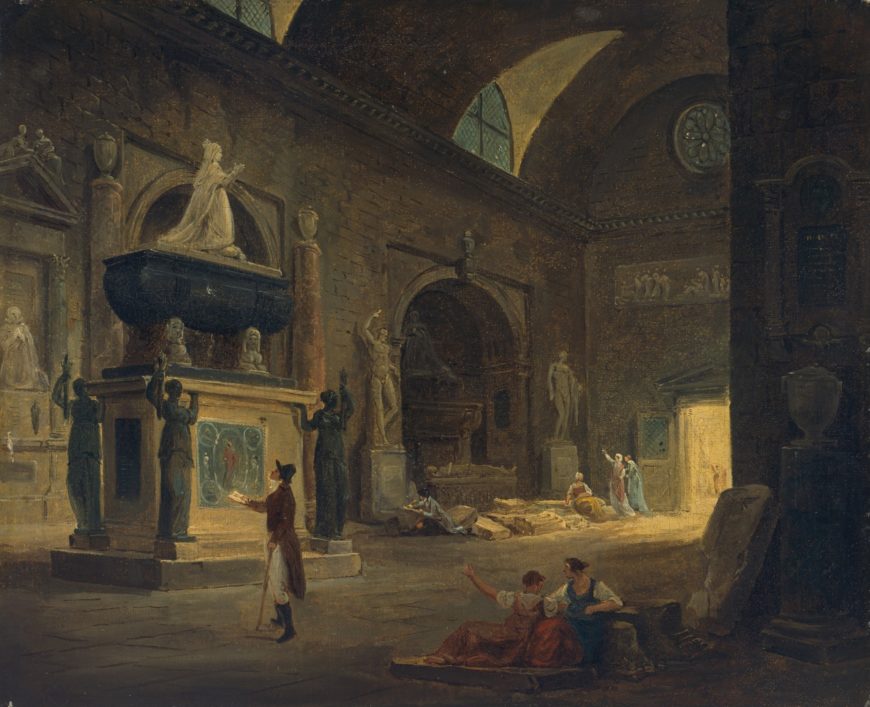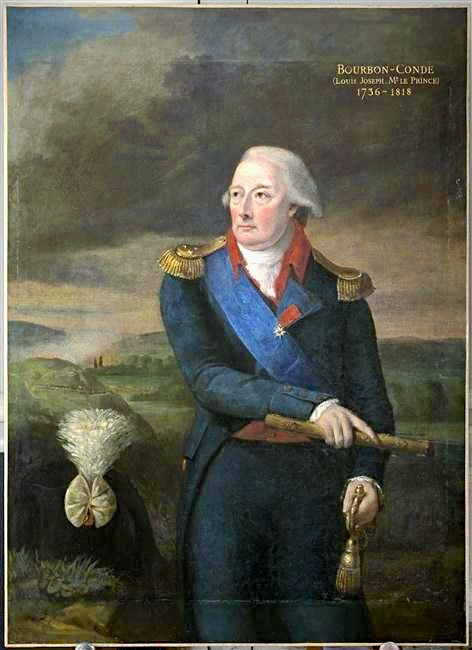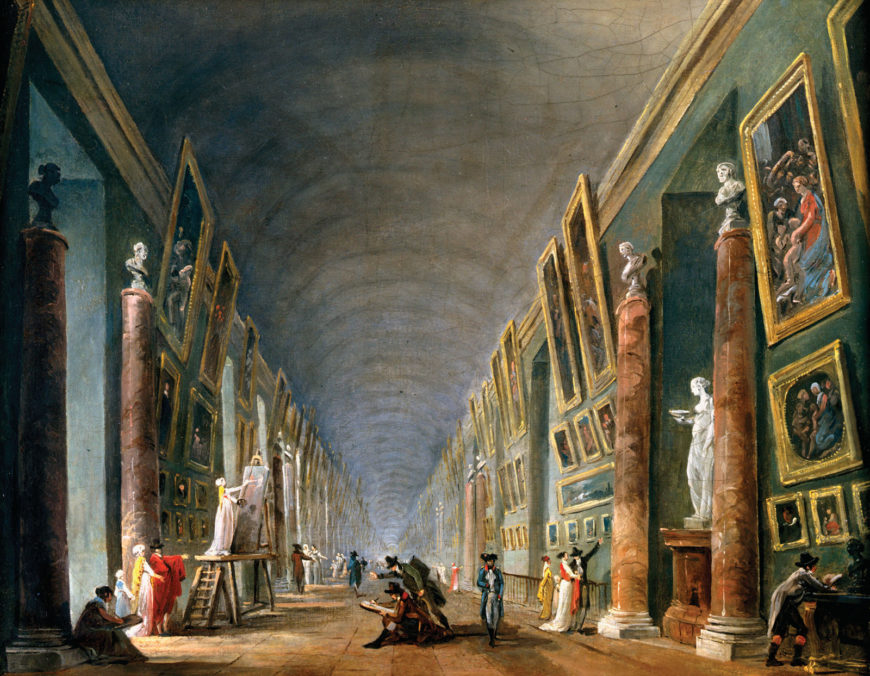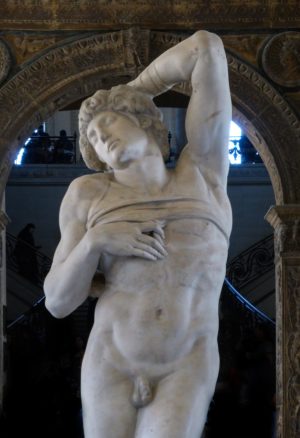What Did the French Do With Their Art Collections From the Louvre and Why?
The Louvre Museum opened its doors on August 10, 1793 every bit the Muséum Français, allowing the French public unfettered admission to the new national fine art drove. Paintings, bronze sculptures, marble tables and statues, porcelain, and other "curiosities" had been organized, labelled, and displayed in the galleries for visitors to enjoy. The exhibition opened to critical acclamation, but past today'south standards, the methods used by the French authorities to gather the Muséum Français' collection in Paris would be considered unethical.

"At the Louis Xv plaza and the Hotel de Ville, the people themselves did justice to the bronze kings themselves, by toppling them to the ground." From Antoine Tournon, Révolutions de Paris, dédiées à la Nation (1792) (Bibliothèque nationale de France)
At the end of the 18th century works of art that represented the social status, politics, and excess wealth of the ancien régime (the political system in France before the Revolution of 1789) became highly contentious objects. They were considered by many to be painful reminders of the grade inequalities in France during the reign of the monarchy. For centuries, the power structure in France had favored the upper classes by furnishing them with dominance and holding rights, which the lower classes were prevented from holding. The monarchy placed limits on the type of property a person could own according to their social condition, enforcing a rigid social bureaucracy. In setting out to build a modern French state, the leaders of the Revolution attempted to implement social, political, and legal reforms to make all citizens equal under the law. They sought an stop to property and financial inequality. The ambitious leaders of the Revolution made property reform a cornerstone of their political platform by attempting to separate the ability to own belongings from form, essentially upending the social order.
Later the revolution, one of the ways the French authorities tried to end the privileges enjoyed past the clergy and nobility (known as the showtime and 2d estates) was to seize their assets, property, and art collections. The fate of their land titles and monetary avails is far too complex to explore in this essay, merely a portion of it was used to finance regime expenses. However, the confiscated art collections were an entirely different matter. Some of the members of state agencies such as the Committee of Public Rubber felt that these objects should exist rejected and destroyed in gild to make fashion for works of art that amend represented the ideals of the Republic. This was at odds with other committees that wanted to preserve national monuments and works of art produced for the ancien régime, arguing that some of these objects were inextricably linked to the identity of French republic and were of national cultural importance. Out of this, the thought of national cultural patrimony developed and confiscated works of art that were in one case emblems of the clergy, nobility, and monarchy were reclassified equally communal belongings and repurposed for the aims of the Revolution (liberté, egalité, fraternité). This was justified in the optics of government officials because it returned the objects to their "rightful" owners: the free French people.
Art collections of religious orders
The first footstep was taken in August 1789, when a decree was passed by the National Assembly suppressing religious orders (including churches, monasteries, and abbeys). This meant that these religious institutions—which had considerable wealth and power—were substantially dissolved, and their property became state property. The clergy had been heavily criticized for their close ties with the monarchy, and more significantly, the enormous power and influence that they wielded. Religious institutions collected tithes, were exempt from taxes, and maintained considerable landholdings, while the lower classes struggled to survive. Anticlerical rhetoric grew and the Associates announced that they would dissolve communally owned ecclesiastical belongings—ending the privileges held by the church. By 1790, the land actively began to seize church building revenue and holding, including works of art, some of which were sold while others were kept due to their cultural and artistic value.

Sculpture and architectural fragments confiscated from French religious institutions displayed at the Museum of French Monuments (Paris) which was open between 1793–1816. Hubert Robert, A Hall in the Museum of French Monuments, 1800, oil on canvas, 38.5 x 46.0 cm (Kunsthalle, Bremen)
While the state-sanctioned art confiscations were ideologically and financially motivated, they also posed a problem. The National Assembly (the kickoff Revolutionary regime) was now faced with the burden of protecting the newly claimed French cultural patrimony since looting and vandalism had become commonplace. Works of fine art, monuments, and buildings commissioned past the ancien régime were attacked, effaced, and sometimes destroyed past the public in lodge to "obliterate the past in pursuit of a regenerated club."[1]
Information technology became clear that the leaders of the Revolution needed to organize a committee to sort, get together, and protect the recently nationalized art collections. Appointed in 1790, the Committee des monuments (sometimes called the College des Quatre-Nations) was a commission of learned antiquarians, artists, and scientists, who were tasked with determining which objects should be sold, kept, or destroyed. They developed guidelines for determining the value and significance of each piece of work of art—making a distinction betwixt objects that were worthy of existence kept for their aesthetic and historical importance and those that were accounted unworthy and could be destroyed (such as commemorative monuments, sculptures, and regal tombs). Objects of artistic and historical importance were kept and placed in temporary storage depots, including the Petits-Augustins and the Hôtel de Nesle, awaiting the institution of museums in Paris and the regional cities.

Portrait of Louis-Joseph de Bourbon, Prince of Condé who fled France and was a leader of the counter-revolutionary movement, 1802, 145 x 107 cm (Musée Condé, Chantilly)
Art collections of the émigrés
As the momentum of the Revolution continued to build, many aristocrats, clerics, commoners (suburbia and wage-laborers), and deportees emigrated to other European countries. Some émigrés were counterrevolutionaries who sought strange assist in attempting to quell the Revolution and to reinstate the Bourbon monarchy. Others simply fled in search of safe, expecting their exile to be temporary. Seeking to punish the émigrés, particularly the counterrevolutionaries, who had taken activity confronting the Revolution, their property was seized and transferred to the state in November 1791.
The confiscation of their holding was deemed necessary for the regime to finance the French regular army's wages to defend against counterrevolutionary armies. The punitive measures taken confronting the émigrés were enshrined in law. Citizenship was essential in whatsoever merits regarding belongings buying, merely required residence in French republic. Thus, the state was not legally obliged to honour the ownership claims of émigrés, since they no longer lived on French soil. More significantly, holding ownership had played a definitive role in determining the partitioning of the social classes during the ancien régime, assuasive the clergy and dignity to dominate the working classes in the third estate. The confiscation of the property of the clergy and the émigrés was intended to shift the ability of land and property ownership to the new Republican regime, who would then, theoretically, redistribute it more equitably among French citizens.
The confiscations were as well intended to inflict personal hurting on the émigrés, especially those who were members of the aristocracy. Many of them had left behind family homes, heirlooms, and meaning fine art collections. In some cases, their property had been in their families for centuries and its value was non merely financial—it was part of their personal identity and information technology indicated their social status. Their inheritances were casualties of war, and not unlike the holding of the clergy, their art collections fell under the purview of the Committee temporaire des arts (1793), which had taken over from the Commission des monuments in dealing with the confiscated works of art.
Fine art collections of the monarchy and the Purple Academies
The appropriation of the purple collection, which had been built over the centuries through tactical acquisitions made by French monarchs and important political figures, such as Jean-Baptiste Colbert (a statesman) and religious figures like Cardinal Mazarin, was far more straightforward. Shortly later the fall of the monarchy on August 10, 1792, the royal fine art collection became public domain, and its fate was tied to the new national museum. It would account for three-quarters of the Muséum Français' collection. The following year, the royal art academies were suppressed (these were institutions which supported and controlled French cultural production—including painting, sculpture, and compages. To the revolutionaries, the members of the academies had taken part in discriminatory admission policies based on class—promoting the interests of a privileged few at the expense of others. Furthermore, the outdated methods of teaching required that students rely heavily on their instructor for guidance and inspiration. Opponents of the imperial art academies pointed out that it was better for students to have access to a national fine art collection containing a variety of works. Students could then copy and draw inspiration from a wide range of objects. The assistants hoped that this would revitalize the French style of art.
A national museum for all
In the early years of the National Convention'due south assistants, information technology was adamant that the confiscated works of art, under the purview of the Commission temporaire des arts, would exist sent to museums beyond the country. The finest pieces would be kept and exhibited in Paris in a dedicated national museum, which was expected to eclipse all other European museum collections in terms of quality and latitude.
A plan to create a national museum in Paris that would house the royal library and the fine art collection had already been established by the monarchy in the 1780s. Nether the direction of the king'south managing director general of royal buildings, Charles-Claude de Flahaut (the comte d'Angiviller), the Louvre Palace, a quondam royal residence, was chosen for the project. Over several years, a team of architects, artists, and art connoisseurs drew up plans to refurbish and convert the palace into a museum. They besides worked to enhance the Crown's fine art drove through new acquisitions. Unfortunately, the project experienced many delays due to a shortage of financing from the king, besides as disagreements nigh the necessary gallery renovations.

Hubert Robert, The Grande Galerie betwixt 1801 and 1805, oil on canvas, 37 × 46 cm. (Louvre)
With the outbreak of the French Revolution, d'Angiviller joined the émigrés in 1791, and the project was abandoned. Information technology would not be resumed until August 1792, when the monarchy was abolished, and the National Convention appear plans to appropriate and complete the museum. A commission was appointed to oversee the preparations for the opening of the new museum. The group assumed responsibility for all national holding and was tasked with the pick of objects for the collection. They began by sending orders for the transfer of works of fine art from the royal residences and the depots, which contained works of art from the suppressed ecclesiastical institutions. The museum assistants faced the herculean tasks of making arrangements for the works of art to exist exhibited in the galleries and organizing minor repairs in time for the yard opening. All the same, they successfully opened the doors to the public in 1793.

Michelangelo's sculptures of the slaves for the Tomb of Pope Julius II came to the Louvre from the collection of King Francis I. Michelangelo, Dying Slave, 1513–xv, marble, 2.09 m high (Musée du Louvre, Paris)
The museum project became a political symbol of the land, illustrating to the French public the stability and ability of the new regime. Known today equally the Louvre, information technology was given the name Muséum Français, highlighting its new function as the museum of the people, accessible to all citizens. Moreover, the museum galleries were intended to be a space where the public could be educated almost history, culture, and the arts. The collection likewise provided source cloth for French artists to copy, which the authorities administration hoped would encourage the production of high-quality works of art.
The works of fine art in the drove had been pried away from their private and privileged settings, and reinvented every bit the nation'due south cultural patrimony. The gallery displays stripped away the original context and function of religious and royal objects, allowing them to exist studied and admired solely for their artistic and historical merit. As objects of curiosity devoid of their associated rituals, the works of fine art appropriated from the clergy, nobility, monarchy, and the royal art academies became symbols of the repudiated past.
Building the Muséum Français' collection through art confiscations irrevocably inverse the purpose of the institution. What began merely as a repository for the majestic art collection was transformed into a political institution, whose administration actively participated in looting works of art from the first and second estates, appropriating them for a new purpose. The local art confiscations in France would eventually lead to the development of retention policies in the 19th century, which ensured that many of these objects were never returned to their erstwhile owners. Many nonetheless reside in the Louvre Museum today, an everlasting legacy of the French Revolution.
[1] Andrew McClellan, "Alexandre Lenoir and The Museum of French Monuments," Inventing the Louvre: Art, Politics, and the Origins of the Modern Museum in Eighteenth-Century Paris (Berkeley, Los Angeles, and London: University of California Press, 1994), p. 155.
Additional resources
1789-1791: The Revolution from Carleton University
History of the Louvre
Museums and Politics: the Louvre
Claude Perrault, East façade of the Louvre
Hannah Callaway, "Revolutionizing Property: The Confiscation of Émigré Wealth in Paris and the Problem of Holding in the French Revolution" (Ph.D. dissertation, Harvard University, 2015)
La Commission temporaire des arts. Instruction sur la manière d'inventorier et de conserver, dans toute 50'étendue de la République, tous les objets qui peuvent servir aux arts, aux sciences et à l'enseignement (Paris: L'imprimerie nationale, 1794)
James Connelly, "The Thousand Gallery of the Louvre and the Museum Project: Architectural Bug," Periodical of the Order of Architectural Historians 31, no. 2 (May 1972): pp. 120–122
Eugène Despois, Le vandalisme Révolutionnaire fondations littéraires, scientifiques et artistiques de la convention (Paris: Germer Baillière, 1868)
Marc Furcy-Raynaud, Les tableaux et objets d'art saisis chez les émigrés et condamnés et envoyés au Muséum central (Paris: Daupeley-Gouverneur, 1913)
Cecil Gould, "The Louvre as a Public Museum." In Trophy of Conquest: The Musée Napoléon and the Cosmos of the Louvre (London: Faber and Faber, 1965)
Abbé Gregoire, Rapport sur les destructions opérées par le vandalisme, et sur les moyens de la réprimer (Paris: Imprimerie nationale, 1794)
Emmet Kennedy, "Vandalism and Conservation," A Cultural History of the French Revolution (New Haven and London: Yale University Press, 1989)
Anatole de Montaiglon and Jules Renouvier, Histoire de fifty'fine art pendant la Revolution 1789–1804: suivie d'une étude sur J.-B. Greuze (Genève: Slatkine Reprints, 1996)
Andrew McClellan, Inventing the Louvre: Fine art, Politics, and the Origins of the Modern Museum in Eighteenth-Century Paris (Berkeley and Los Angeles: Academy of California Press, 1994)
Édouard Pommier, "Le génie des arts et le génie de la liberté: régénération, destruction, conservation," L'art de la liberté: doctrines et débats de la Révolution française (Paris: Gallimard, 1991)
Dominique Poulot, "Le musée révolutionnaire, un musée vandale?," Une histoire des musées de France XVIIIe- XXe siècle (Paris : La Découverte, 2008)
Daniel Sherman, "Museums in Formation, 1791–1850," in Worthy Monuments: Art Museums and the Politics of Culture in Nineteenth-Century France (London and Cambridge: Harvard University Press, 1989)
Henri Stein, État des objets d'fine art placés dans les monuments religieux et civils de Paris au début de la Révolution Française (Paris: Charavay Frères, 1890)
Jules Tardif, Monuments Historiques: Cartons des Rois. Inventaires et Documents publiés par ordre de fifty'Empereur sous la direction de M. le Marquis de Laborde (Paris: J. Claye, 1866)
"Beaux-Arts sur le Muséum des arts de Paris: Coup-d'œil sur le local et la disposition des tableaux," La décade philosophique, littéraire et politique par une société de Républicains 4 (Paris, 1794), pp. 211-217.
Cite this page as: Cynthia Prieur, "Local art appropriation in French republic—a written report of the loot in the Louvre Museum," in Smarthistory, September viii, 2020, accessed April 25, 2022, https://smarthistory.org/loot-louvre/.
Source: https://smarthistory.org/loot-louvre/
0 Response to "What Did the French Do With Their Art Collections From the Louvre and Why?"
Post a Comment